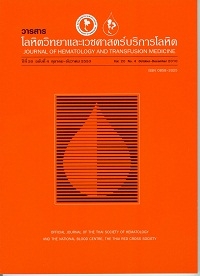ลักษณะทางคลินิกและการรักษาผู้ป่วยที่มีภาวะหลอดเลือดดำอุดตัน ในโรงพยาบาลเมืองฉะเชิงเทรา
Keywords:
ภาวะหลอดเลือดดำอุดตัน, Doppler ultrasonography, มะเร็ง, Deep vein thrombosis, Cancer, Obesity, Estrogen, WarfarinAbstract
บทคัดย่อ
การศึกษาในโรงพยาบาลมหาวิทยาลัยพบว่าอุบัติการณ์ของโรคหลอดเลือดดอุดตันสูงขึ้นมากในผู้ป่วยไทย แต่ยังไม่มีการศึกษาในโรงพยาบาลที่อยู่ในชุมชน วัตถุประสงค์ : เพื่อศึกษาลักษณะทางคลินิกของผู้ป่วยหลอดเลือดดำอุดตัน ในโรงพยาบาลทั่วไปเพื่อให้เข้าใจถึงสาเหตุ ปัจจัยเสี่ยง การวินิจฉัย การรักษา และการพยากรณ์โรคของผู้ป่วยที่มีต่อภาวะหลอดเลือดดำอุดตัน และนำไปสู่การดูแลรักษาผู้ป่วยที่มีประสิทธิภาพในอนาคต วิธีการ : ผู้วิจัยได้รวบรวมข้อมูล review เวชระเบียนผู้ป่วย ตั้งแต่ มกราคม 2549 ถึง ธันวาคม 2552 โดยปัจจัยที่ศึกษา ได้แก่ ลักษณะพื้นฐานของผู้ป่วย คือ อายุ เพศ ดัชนีมวลกาย โรคประจำตัว ประวัติสูบบุหรี่ performance status ประวัติการใช้เอสโตรเจน ตำแหน่งที่เกิดหลอดเลือดดำอุดตัน การตรวจทางห้องปฏิบัติการพื้นฐาน ยาที่ใช้รักษา และภาวะแทรกซ้อนที่เกิดขึ้น ผลการศึกษา : ผู้ป่วยทั้งหมด 56 คน อายุเฉลี่ย 50.0 ฑ 17.0 ปี เป็นเพศหญิง 33 คน (ร้อยละ 58.9) ได้รับการวินิจฉัยโดยอาการทางคลินิกร่วมกับ Doppler ultrasonography ทุกราย ลักษณะทางพื้นฐานของผู้ป่วย พบความอ้วน (BMI มากกว่า 25 kg/m2) 5 คน โรคร่วมทางด้าน atherosclerosis risk ไม่มีความแตกต่างระหว่างทั้งสองเพศ การศึกษาลักษณะทางคลินิก พบว่าตำแหน่งของภาวะหลอดเลือดดำอุดตันเกิดที่ขาซ้ายบ่อยกว่าขาขวามาก (ร้อยละ 85.7 เทียบกับ 8.9) โดยพบมากที่ Iliofemoral vein ร้อยละ 80.4 ปัจจัยเสี่ยงของการเกิดภาวะ DVT พบว่า เกิดจาก ภาวะมะเร็งมากที่สุดร้อยละ 26.8 ไม่ทราบสาเหตุร้อยละ 23.2 ผู้ป่วยหลังผ่าตัดโดยเฉพาะทางศัลยกรรมกระดูก ร้อยละ 10.7 ผู้ป่วยทุกรายได้รับการรักษาด้วย low molecular weight heparin ตามด้วย warfarin อย่างน้อย 6 เดือน ปรับ INR อยู่ในช่วง 2.0 – 3.0 พบว่าไม่มีภาวะแทรกซ้อน เลือดออกรุนแรงหรือเสียชีวิต แต่มีเลือดออกไม่รุนแรงร้อยละ 8.9 ติดตามผลหลัง warfarin ครบ 6 เดือน พบมีภาวะ post thrombotic syndrome ร้อยละ8.9 สรุป : ผู้ป่วยลิ่มเลือดอุดตันในเส้นเลือดดำพบในเพศหญิงมากกว่าเพศชาย ตำแหน่งที่เป็นพบขาซ้ายมากกว่าขาขวา ปัจจัยเสี่ยงของการเกิดภาวะหลอดเลือดดำอุดตันพบว่าเกิดจากมะเร็งมากที่สุด
Key Words : ภาวะหลอดเลือดดำอุดตัน, Doppler ultrasonography, มะเร็ง
Abstract
Studies in university hospitals showed that the incidence of venous thromboembolism (VTE) is increasing among Thai patients. However, there is no study in community hospitals. Objective : The aim of the study is to determine the clinical characteristics of deep vein thrombosis (DVT) patients incommunity hospital. These clinical clues may be helpful to identify the risk factors, diagnosis, treatment and prognosis of DVT patients. These may improve quality of care for the patients in the future. Methods : Medical records of objectively-confirmed DVT patients in Chachoengsao Hospital from January 2006 to December 2009 were reviewed. The variables were age, sex, body mass indices (BMI), underlying diseases, smoking history, previous hospitalization, performance status, estrogen uses, sites of DVT, routine laboratories, treatments and their complications. Results: There were 56 patients. Thirty three were female (58.9%). The mean age was 50.0 ± 17.0 years. There was no significant difference in mean ages, BMI, atherosclerosis risk, co-morbidity between sexes. Left leg DVT was much more common than the right ones (85.7% vs. 8.9%). The most common affected vessel was the iliofemoral vein (80.4%). DVT was associated with malignancy in 26.8%, idiopathic in 23.2% and post operative (hip and knee surgeries) in 10.7%. All patients were treated with low molecular weight heparin followed by warfarin for at least 6 month with the target INR of 2-3. No major bleeding or fatality occurred during follow-up. However, minor bleeding and post thrombotic syndrome were found in 8.9% each. Conclusion : DVT in this study was more common in female and in a left leg. Malignancy was the most common risk factor.
Key Words : Deep vein thrombosis, Doppler ultrasonography, Cancer, Obesity, Estrogen, Warfarin



